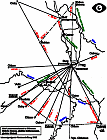
Translated from “Böhmische Dörfer – geortet!”,
Germanien, 1940, 475–476.
A postscript to the author’s article “Frühdeutsche Landmessungen” (“Early German land surveys”), presenting evidence for the use of the 11-km unit south of Prague.
To the essay on “Early German land surveys” (Ref. 1) the following observations may be added.
 A village Ostra in or near Dresden does not admit orientation on Prague. Its relations are with Meissen.
The village belonged to the bishops of Meissen;
it was obliged to provide the jurors for the bishop’s court in nearby Briesnitz and to
call the guilty villagers to judgement. “But the officials had the option of transferring such a court to
Ostra” (Ref. 3). Ostra lies 22 km away from the bishop’s palace and cathedral in Meissen.
A village Ostra in or near Dresden does not admit orientation on Prague. Its relations are with Meissen.
The village belonged to the bishops of Meissen;
it was obliged to provide the jurors for the bishop’s court in nearby Briesnitz and to
call the guilty villagers to judgement. “But the officials had the option of transferring such a court to
Ostra” (Ref. 3). Ostra lies 22 km away from the bishop’s palace and cathedral in Meissen.
A village Ostrau north of Döbeln lies 22 km west of Meissen.
Ostro castle lies near Veltrusy in Bohemia, 22 km north of the citadel and cathedral precincts in Prague, on the line running over St George’s Hill and the Matzenstein to the Königstein. The Königstein has an old free-standing church of St George at its centre. The church of St George on the citadel in Prague was built in 912 by Duke Vratislav I. In 971 Boleslav II’s sister Milada founded a Benedictine convent nearby, the oldest in the country.
A village Ostrov lies 22 km northeast of the Prague citadel, near Brandys.
A village Ostro lies 44 km southwest of Prague. A hill Ostry is situated 44 km from Prague in a WSW direction. These places have the property that in each case a village Žebrák lies SE of the first, NW of the second, at equal distances; midway between these Ostro sites is a hill Chlum, also 44 km from Prague.
Again, a hill Žebrák lies south of Benešov and southeast of Prague, 44 km from the cathedral precincts. All three Žebrák sites (there are no others on the three neighbouring sheets of the official 1:200 000 map) are equidistant from Prague, and the two outer ones lie 33 km from the central Žebrák. The angles formed by joining these sites to Prague are both 45 degrees.
The more westerly of these 45-degree angles is divided into four angles of 11¼ degrees, by lines running out from Prague to the above-mentioned points Ostrov, Chlum, and Ostry.
The arrangement of all these sites is not accidental: starting from Prague they are based upon the equilateral triangle created by the Benedictine monks about 1000, through the founding of Ostro monastery at the mouth of the Sázava, and the settlements made by the hermits of St John sent from Sedlec on the Lodenice. At that time a further hermit went to Mount Veliš; a line from Veliš to Prague (citadel) would make a further angle of 11¼ degrees with the line to the westernmost Žebrák, where there was a royal castle. The extension of the line Prague–Ostro monastery meets, at 44 km from Prague, another village Chlum; while the extension of the line Sedlec–Žebrák meets, about 20 km SW of Žebrák, a hill Chlum. Then a village Chlum lies 44 km west of Prague.
The Czech “žebrák” means “beggar”. Thus we may safely assume that monks were sent into the forest wilderness by the Benedictines, like the hermits of St John’s chapel and Mount Veliš, and that these outposts, in carrying out their duties of giving directions and collecting long-distance information, were dependent upon gifts of food from travellers, just as the church on Mount Veliš was cared for by the villagers of Otročiněves.
For the angles imprinted on the landscape round Prague by the Žebrák–Ostro–Chlum sites were not arbitrary ones. Our compass division of 360 degrees has a forerunner in the 32-fold compass rose, which is still in use today and guided the miners in the Middle Ages. A 32nd of the 360-degree circle is 11¼ degrees.
At a distance of 44 km from the centre, tangents of 33 km will be cut off by sighting along four divisions of the 32-fold windrose. It was only necessary make a single exact measurement with a cord: all further lengths could be found by setting out angles. The fact that since the Bronze Age our weather has had reduced visibility and increased rainfall (pollen analysis) supports the idea that it was formerly much easier to send messages into the far distance without optical aid.
At any rate the planning in Frankish settlements, to which W. Kaspers (Ref. 2) has recently drawn attention, has a parallel in the Bohemia–Lausitz–Meissen area. Out of the bewildering and seemingly chaotic profusion of the Bohemian villages, one can find in the above (and I have resisted the temptation to include every suggestion) clear proof of deliberate orientaticn in the mountains, whose inhabitants, in their religious duties or in the service of their prince, needed hermits as guardians and builders of roads, and as pioneers of culture, to bridge the wastes and forests of the Markwald and link together the inhabited districts.
Kurt Gerlach
| 1. | Germanien, 1940; reprinted above. |
| 2. | Kaspers, W. “Schematismus in der fränkischen Siedlungsanlagen und deren Namen”, Zeitschrift für Namenforschung, 14, 129–141. |
| 3. | Trautmann, O. Das Ostra-Vorwerk. Dresden 1918. |